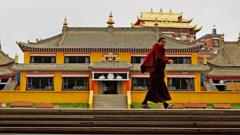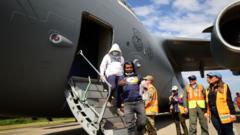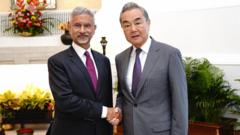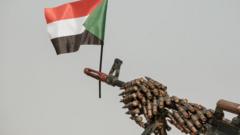As the Dalai Lama turns 90, tensions in Tibet intensify. Monks from the Kirti monastery express concerns over oppression and surveillance under Chinese governance, signaling a growing resistance movement. Beijing's efforts to control the succession of the Dalai Lama further adds to the urgency, as Tibetans seek to preserve their identity amidst repressive policies.
Tibetan Resistance Grows as Dalai Lama's Future Sparks Tensions with China

Tibetan Resistance Grows as Dalai Lama's Future Sparks Tensions with China
With the Dalai Lama's 90th birthday approaching, tensions rise as Tibetans continue to resist Chinese rule and grapple with their spiritual leader's succession.
The shadow of resistance looms heavily over the Kirti monastery in Aba, Sichuan province, as Tibetan monks openly voice their concerns about the oppressive environment shaped by decades of Chinese rule. Marking the Dalai Lama's 90th birthday this week, the monastery has become a focal point for conversations around Tibetan identity, freedom, and the future leadership of their faith.
Monks, cloaked in traditional crimson robes, navigate a climate of surveillance and crackdowns. The presence of police stations and surveillance cameras within the monastery’s walls indicates the lengths the Chinese Communist Party (CCP) will go to maintain control. "Things here are not good for us," one monk quietly remarked, aware of the risk posed by their expressive dissent.
The Kirti monastery earned its notoriety as a center of resistance during the 2008 Tibet-wide uprising, which saw violent clashes between local protesters and armed forces. This remote town reflects the broader struggle of over six million Tibetans, living under a regime that seeks to suppress their cultural and spiritual practices. Although the Chinese government asserts that Tibetans enjoy religious freedom, evidence from local sources suggests a systematic erasure of Tibetan identity, with religious practices increasingly subjected to scrutiny and control.
The Dalai Lama's announcement about his succession plans has heightened these tensions. With the prospect of a new spiritual leader following his passing, differing viewpoints among Tibetans about the future of their faith are emerging. While some express hopefulness for a choice made outside of China, emphasizing autonomy, followers within Tibet remain largely uninformed due to stringent censorship. Beijing has already indicated that it will administer the next Dalai Lama's identification process, affirming its influence over Tibetan spiritual life.
In light of these developments, Tibetans are not only fighting for their religious beliefs but are also grappling with legislation limiting the education of Tibetan children. Chinese mandatory schooling policies are cited as a means to further assimilate Tibetan youth into the national narrative, raising alarm among community leaders about the future of Tibetan Buddhism.
As Beijing enhances its methods of control, investments in infrastructure and tourism appear to symbolize prosperity; however, these efforts are examined by many as attempts to dilute Tibetan culture and heritage. The juxtaposition of economic development with cultural oppression showcases an ongoing battle for the hearts and minds of Tibetans, who strive to protect their identity against the rising tide of assimilation.
Tension is palpable within the Tibetan community, considering the Dalai Lama’s expressions concerning the future of their leadership. In this struggle for spiritual sovereignty, both sides prepare for a pivotal challenge, with China's manipulation of religion testing the resilience of Tibetan identity. The landscape of resistance remains complex, with vigilance needed to navigate a future where the very essence of Tibetan belief is at stake.

















